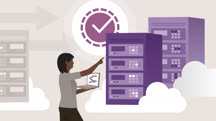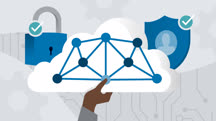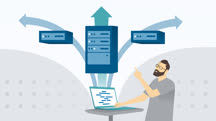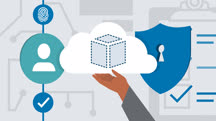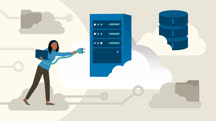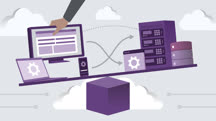Course catalog
Categories
Showing 1,001-1,020 of 9,134 items.
AWS: Automation and Optimization
Learn strategies for optimizing, automating, and auto-scaling processes. Get some guidance around how to control costs while successfully managing cloud operations using AWS.
AWS: Controlling Cost (234461)
Learn how to use Amazon Web Services (AWS) tools and best practices to understand, forecast, and control service costs. This course covers core AWS tools, such as CloudWatch billing alarms, consolidated billing with AWS Organizations, and the AWS billing dashboard tools. Instructor Lynn Langit shows how to control costs through key services, such as EC2, S3, RDS, and more. She also reviews architectural decisions related to cost control drawn from her own professional experiences.
AWS: Cost and Performance Optimization (230551)
As more and more organizations move their workloads and resources to the AWS cloud for its speed, elasticity, and flexible pricing options, it’s more important than ever to optimize processes to avoid extra costs and a heavy burden on resources. In this course, Shyam Raj provides guidance around controlling cloud costs and optimizing performance of apps in AWS. Shyam begins by discussing cost optimization strategies and best practices for improving resource performance. He then showcases AWS services designed to help monitor costs and those designed to help reduce cost by optimizing performance, covering AWS tools like AWS Budgets, Trusted Advisor, and Compute Optimizer. This course also covers the knowledge needed for anyone who is preparing for the corresponding domain of the AWS SysOps Administrator certification exam (SOA-C02).
AWS: Disaster Recovery
Learn how to use Amazon Web Services for disaster recovery (DR). Discover how to configure backups and perform cold failover, pilot light, and warm standby recoveries.
AWS: Enterprise Security
Implement AWS securely. Learn about the different security tools within AWS—Identity and Access Management (IAM), Key Management Service (KMS), and more—as well as how to use them.
AWS: High Availability
Learn how to build out a highly available, resilient environment for your applications using the tools in Amazon Web Services, including Route 53, Auto Scaling, RDS, ElastiCache, and more.
AWS: Monitoring and Reporting
Take an intermediate-level look at monitoring and reporting for the AWS platform. Learn how to work with CloudWatch, AWS Config, AWS Lambda, and more.
AWS: Monitoring, Logging, and Remediation (232727)
As organizations increasingly move their workloads to the AWS cloud to take advantage of its speed, elasticity, and flexible pricing, it is more important than ever to continuously monitor your applications and workloads, and react to changes, to maintain a fault-tolerant and highly available ecosystem. In this course, Shyam Raj provides system administrators with a look at how to successfully monitor resources and applications and how to remediate problems that may arise. Shyam includes heavy coverage of AWS monitoring services, including CloudWatch, CloudTrail, and AWS Config. He explains how to navigate the dashboards of these services to view metrics, monitor performance, and configure resource limits. This course can also be used to prep for the corresponding domain of the AWS Certified SysOps Admin exam.
AWS: Networking (232744)
Adopting a cloud infrastructure strategy includes configuring a network that meets the needs of your organization. Amazon Web Services (AWS) is a cost-reducing solution that provides tools so you can build a data center with secure cloud networking technology. This course offers advice for technical managers and step-by-step instructions for system administrators and full-stack engineers. Learn how to establish private connections, set up a virtual private cloud, implement and configure Transit Gateway, create security groups, work with access control lists, and more. Plus, get troubleshooting tips and learn how to leverage AWS services such as CloudFront to securely deliver content to customers globally with low latency. Join IT architect Sharif Nijim as he takes you through foundational networking concepts and beyond so you can gain a broader and deeper sense of effective strategies and tools you can use.
AWS: Networking
Learn how to configure and deploy a network using Amazon Web Services. Get step-by-step instructions on how to set up, secure, and connect data centers for your organization.
Azure Active Directory: Basics
Get up and running with Azure Active Directory, a cloud-based identity and access management service for on-premises, cloud, and hybrid environments.
Azure Administration Essential Training
Get a cloud administrator's view of Azure. Learn how to use its cloud-based storage and networking services, which can scale up or down as your organization changes.
Azure Administration: Business Continuity
Help your organization overcome unexpected or challenging events by implementing an effective business continuity plan using options in Microsoft Azure.
Azure Administration: Configure and Manage Virtual Networking
Learn how to configure and manage virtual networks (VNets) on Azure.
Azure Administration: Deploy and Manage Compute Resources (220521)
Effectively managing compute resources is key to infrastructure administration—and a successful career in IT. In this course, instructor Sharon Bennett discusses how to successfully deploy and manage Microsoft Azure compute resources, focusing heavily on configuration of virtual machines. Sharon shows how to configure VMs for high availability and scalability, set up encryption, provision VMs, and automate VM deployment and configuration with Azure templates. She also teaches how to create and configure containers and web apps. This course is also a valuable resource for anyone preparing for the corresponding domain of the AZ-104 Azure Administrator certification exam. Level up your Azure skills today with these hands-on demos and practical techniques.
Azure Administration: Deploy and Manage Virtual Machines
Learn how to deploy and manage Azure virtual machines—key skills tested on the Azure Administrator certification exam.
Azure Administration: Identities and Governance
Learn how to secure access to your resources using Azure identity and governance services. This course also prepares you for the Microsoft Azure Administrator exam (AZ-104).
Azure Administration: Implement and Manage Application Services
Learn how to build scalable apps that can be deployed worldwide with Azure App Service.
Azure Administration: Implement and Manage Storage
Get started in Azure administration. Learn how to manage Azure storage, including Blob storage and file shares, and study for Microsoft Azure Administrator exam (AZ-104).
Azure Administration: Load Balancers and Application Gateways
Learn how to effectively implement Azure load balancers and Azure Application Gateway for the distribution of web apps.





